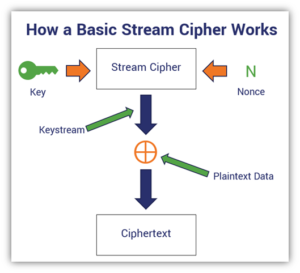In an age where digital content proliferates at an unprecedented rate, the safeguarding of large video files has become paramount. With a myriad of options available for encryption, two key methodologies often enter the discussion: block ciphers and stream ciphers. By delving into the intricacies of these two encryption types, we can better understand their capabilities and limitations concerning the encryption of substantial video files.
Block ciphers and stream ciphers each serve a unique role within the cryptographic domain, catering to various requirements. Block ciphers, as the name implies, encrypt data in fixed-size blocks, typically ranging from 64 bits to 256 bits. Their strength lies in their ability to apply robust encryption algorithms to larger datasets, necessitating a comprehensive understanding of the data structure for optimal effectiveness. Conversely, stream ciphers encrypt individual bits or bytes of data in a continuous stream, offering real-time encryption capabilities that can be highly advantageous for applications involving live video transmission or data requiring instantaneous protection.
When faced with the daunting task of encrypting large video files, the choice between these two types of ciphers often sparks debate among cryptography enthusiasts and professionals alike. The observation that video files contain an extensive amount of data challenges potential encryption solutions. In this context, it is essential to understand not only the encryption mechanisms themselves but also the characteristics of the video files at hand.
Video files are distinguished by their exceptional sizes, which can frequently exceed gigabytes. This significant volume introduces considerations regarding efficiency and latency, particularly when dealing with streaming scenarios. Stream ciphers may appear advantageous in such situations, given their ability to encrypt data in real time without necessitating the entire dataset upfront. They function by generating a key stream that is combined with the plaintext, allowing for immediate transmission while maintaining confidentiality.
On the other hand, while block ciphers may impose an initial overhead due to their requirement for processing fixed-size blocks, they provide inherent advantages that merit discussion. The capacity for block ciphers to employ certain cryptographic modes, such as Cipher Block Chaining (CBC) or Galois/Counter Mode (GCM), can bolster both security and efficiency. These modes introduce mechanisms for error propagation and data integrity, essential attributes in the context of video files that may be subject to corruption or interception during transfer.
Nevertheless, the decision regarding which cipher to employ transcends mere efficiency. It invites reflection on the broader context of encryption — the reasons behind it and the implications of its implementation. Encryption serves as a buffer against potential threats, a safeguard against unauthorized access to sensitive information contained within video files, which may include private communications, intellectual property, or highly sensitive material.
The allure of encryption lies, in part, within the inherent tension between accessibility and privacy. While the digital landscape thrives on the seamless sharing of information, the growing proclivity for cyber threats demands robust defenses. Consequently, individuals and organizations must weigh the necessity of securing their large video files against the operational implications of employing block or stream ciphers. Decisions should be grounded in the nature of the content, the intended audience, and the potential fallout from a data breach.
Another compelling aspect of this discussion is the evolution of cryptographic algorithms and their adaptation to the demands of contemporary digital environments. Advancements in technology have arguably rendered traditional algorithms more susceptible to vulnerabilities. Hence, the continuous evaluation of cipher effectiveness is vital, fostering a nuanced understanding of when and how to apply block or stream ciphers for video file encryption.
As individuals and organizations navigate this landscape, it is crucial to recognize that large video files may demand a hybrid approach to encryption. Utilizing block ciphers for stored files while employing stream ciphers for real-time transmission could offer a balanced solution, addressing the unique challenges posed by each method while maximizing security.
Furthermore, the integration of metadata security in conjunction with video file encryption deserves attention. Large video files often encapsulate metadata that may provide valuable insights into the content and context of the video. Ensuring the confidentiality of this metadata alongside the video footage can further fortify defenses against unwanted scrutiny. Techniques such as tokenization can obscure metadata while enabling authorized access, safeguarding against potential exploitation.
A comprehensive encryption strategy for large video files must also consider compliance with industry regulations and standards. Certain sectors, such as healthcare or finance, may impose stringent requirements regarding data protection, necessitating a rigorous evaluation of the chosen encryption methods. This underscores the need for organizations to stay abreast of evolving compliance mandates while maintaining robust encryption protocols.
In conclusion, the question of whether to employ block or stream ciphers for encrypting large video files extends far beyond a technical preference. While each method possesses distinct advantages and disadvantages, the decision should derive from a confluence of factors, including operational requirements, data sensitivity, and compliance standards. As the digital landscape continues to evolve, a thoughtful and adaptive approach to encryption will ensure that large video files remain secure amidst increasingly sophisticated threats.









Leave a Comment